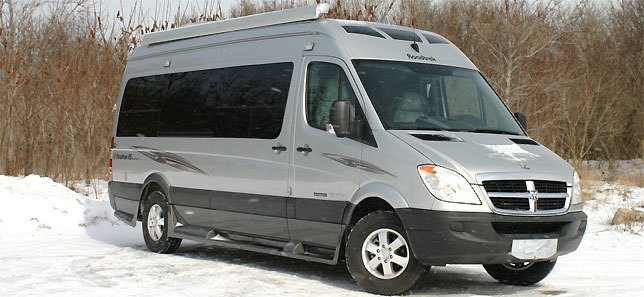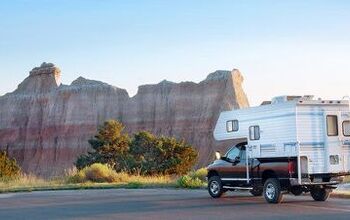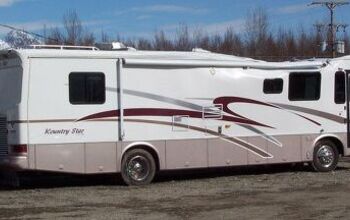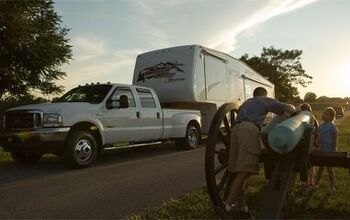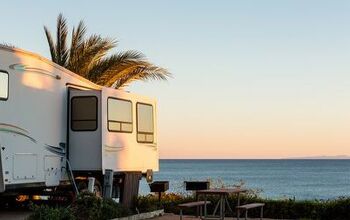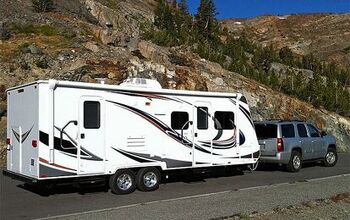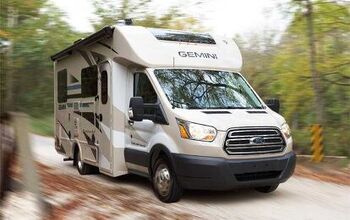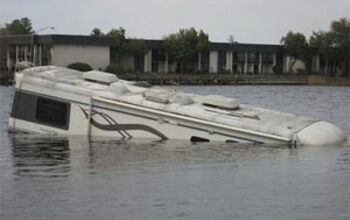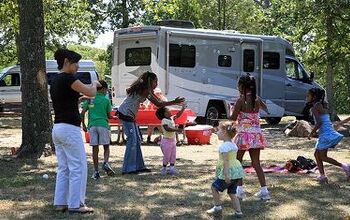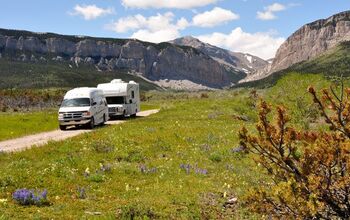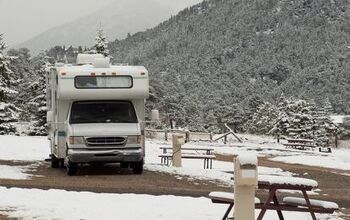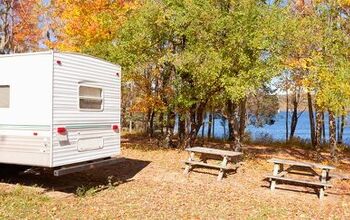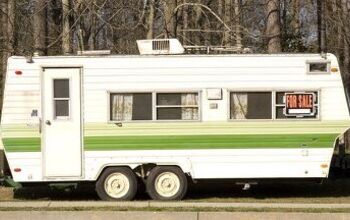2009 Roadtrek RS-Adventurous Review
Less than perfect weather is a vacation reality; same as it is when I do road tests. However sometimes I change dates by days or even weeks to avoid rotten weather – but when I get just one day to test an RV I have no choice but to take what I get weather-wise.
When I went for the test of the Roadtrek Class B motorhome in Kitchener, Ont. a light snow fell when I arrived at the factory. The mercury was at about 15F, which wasn’t too bad – but the winds were gusting to 35 mph. All told, it was not an ideal testing scenario. But, as the day wore on, it occurred to me that this poor weather drive frankly offered the best test conditions I could have hoped for. I mean, in perfect weather, every vehicle seems to drive well – so keep this weather picture in mind as I describe my test of the 2009 Roadtrek RS-Adventurous.
Based on the Dodge Sprinter 2500, this is the largest Class B that Roadtrek currently builds. While this is now the second generation to be sold in North America it’s important to remember that this van is the staple of the European parcel and vocational market – and has been for at least the past twenty years. In fact the Sprinter is the top selling cargo and passenger van built as a Mercedes-Benz in Europe.
This is a ¾ -ton platform powered by a Mercedes-Benz 3L diesel engine pushing power to the rear wheels through a five-speed automatic transmission. This diesel makes 154 hp and has a torque rating of up to 280 lb-ft. This newest engine comes with a new aluminum crankcase, a balancer shaft and two overhead camshafts per cylinder bank. Dodge says this smoothes out vibration and I’d agree with them. Fuel economy is said to easily top 20 miles to the US gallon.
One of the best things about using the Sprinter as a base for this construction is that with its mega-roof option and large doors (meant to accept full pallets) Roadtrek can concentrate on the interior decor and systems – there is no need to raise the roof or lower the floor. What this means from an engineering standpoint is that all the chassis components, suspension parts, running gear and powertrain were designed and tested to work best within the shell that the builder designed. No body changes means this best handling package remains in force. And this point is the one that I want to stress as the RV’s handling during that winter storm was well demonstrated.
The Sprinter is a tall vehicle, but with a low centre of gravity and a long wheelbase it held to its own lane despite the buffeting of these pesky crosswinds. This feeling of solid control was enhanced by a new standard rack-and-pinion power steering that is also height and tilt-adjustable. In addition to the steering being power assisted it is also speed-sensitive and applies a variable-ratio response to steering input; the key benefit here comes during parking and tight maneuvering, but on the highway I could just hold the wheel and even though the unit rocked hard with the force of the wind it never wandered.
The layout of the cockpit is similar to any pickup truck with the added benefits of a very large windshield, a blunt nose that drops out of sight, excellent heated mirrors and a short shift lever that is mounted almost at the driver’s right knee. It slides in and out of gear seamlessly and it can be shifted manually by the driver with a flick of the lever- right or left. Working with the engine braking this feature is particularly handy on long downhill grades holding a steady speed and saving the brakes which are discs all around.
Much of the impressions I picked up while driving the RS-Adventurous were processed with the idea that RVers who would be interested in a unit like this will do a lot of driving. Frankly that is what this unit is best for – as opposed to spending weeks at a time parked. I found that along with its easy road manners I loved the Sprinter for its easily negotiated square body. I’d take this unit down through Manhattan or up through old Montreal without a second thought. I felt completely comfortable behind the wheel. In fact, many people who are drawn to a vehicle like this have professions and hobbies that require towing a trailer. For them the Sprinter will also tow up to 5,000 lb, and it can be ordered with the hitch and electrical couplings right from the factory.
Just behind the cockpit are two other adjustable, swiveling high-backed seats equipped with seatbelts. And while it’s usually a couple who travel in unit like this if there are back seat passengers they are by no means treated as an afterthought. The seating is comfortable and the full glass sides of this RV afford an excellent view no matter where the passenger sits. These positions even have their own window openings. They also have their own door. On the passenger side is the large sliding door that has a handy powered step that extends and retracts automatically when the door is opened or closed. There is also plenty of room to stretch out and a post-hole in the centre of this space will support the tabletop which is stored beside the left hand seat. This table will also fit another post-hole just in front of the powered fold-down couch in the rear of the unit – but the benefit of having it set up forward is that the beds don’t have to be unmade to accommodate it.
The galley and bathroom are opposite each other in the center of the van and each is surprisingly large. The kitchen counter (made of granite) has prep space as well as the sink cover and cooktop imbedded in the stone. Above are cupboards and fine touches like a built-in spice rack. The wood is all cherry and most of it is solid. Hardware on the cupboards supports the doors – holding them open at any angel, but they also have push-button latches. Even in the windstorm, while driving, I noticed that nothing rattled. Below the counter are the 3.8 cu-ft Dometic 3-way refrigerator and the Convection/Microwave (I’m told you can bake a cake in it – I’ll have to take their word for that). While standing at the sink I noticed that though I’m six-feet tall I had at least another 3-inches of headroom – I even fit under the A/C unit vent in the rear. The only exception to this height is up front so when walking into the cockpit – remember to duck – I didn’t, ouch!
My other observation is that this real space is enhanced by all the glass that simply makes the unit “feel” larger than it is. On that note two other things come to mind. One – while driving I actually used the rear view mirror and I was able to easily do shoulder checks while changing lanes – there is that much glass. Two – each window has either a day/night pull-down shade, or curtain – so at night full privacy can be had. Note though, over the cooktop the blinds are metal – splash resistant and easier to clean.
Across the aisle (which is 28-inches wide) is the wet bath nicely set in a decent space with two doors that open like wings. Again these are beautifully done in solid hardwood. These are easily latched when not in use but when using the toilet can be locked into a second expanded position that just simply makes taking care of business that much easier. I noted (and suggested to the manufacturer) that when the doors are fully open they should latch in that position. This came up because I was on a slight hill when I was working with them and of course one side wouldn’t stay open. When using the shower a plastic curtain that follows a slight outward curve keeps everything dry.
Storage in a Class B is always an issue and I wouldn’t suggest that there is more storage than the footprint of the van will allow. Instead I will say that I saw every usable square inch used economically and the rest devoted to storage of every shape and size. Much like designing a yacht, where space is also at a premium, this Roadtrek follows the same principles right down to cut-outs in the inner van wall that access space between the support studs.
In my test unit the rear of the van held the power fold-down couch that would easily seat three and becomes the head of the king-size bed – or the top of a pair of singles. It’s wholly up to you how you’d like the sleeping arrangements made up. Also back there is the entertainment centre consisting of a DVD player, flatscreen TV that can be easily positioned and a surround sound system with ceiling mounted speakers that will channel the radio/TV or both.
A feature that I didn’t have – but which will soon be installed in these units is a backup camera that will project onto the touch screen included with a new Radio/GPS/Bluetooth system.
Certainly another advantage to an RV of this size is its ability to go just about anywhere – of course then you need services when you get there –right? Well with an Onan MicroLite propane generator (2.5KW), power inverter with charger, 16,000 BTU furnace, heated fresh and waste water tanks, and A/C boondocking will not be much of a challenge.
I enjoyed my time in the Roadtrek, despite the weather.
